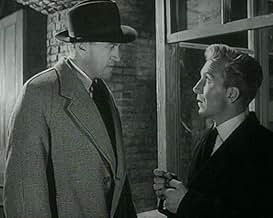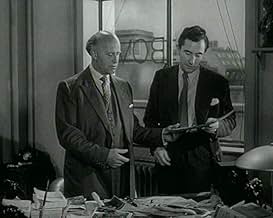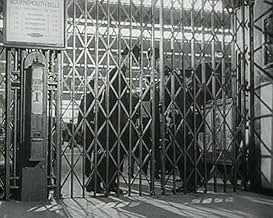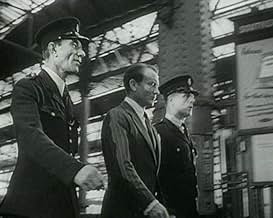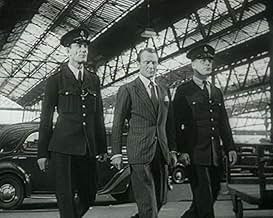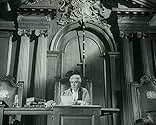IMDb RATING
7.0/10
1.4K
YOUR RATING
Released from prison after twelve years, a wrongfully convicted British man seeks revenge on the witnesses who lied at his trial.Released from prison after twelve years, a wrongfully convicted British man seeks revenge on the witnesses who lied at his trial.Released from prison after twelve years, a wrongfully convicted British man seeks revenge on the witnesses who lied at his trial.
- Director
- Writers
- Stars
Michael Martin Harvey
- Jackson
- (as Michael Martin-Harvey)
- Director
- Writers
- All cast & crew
- Production, box office & more at IMDbPro
Featured reviews
When I first saw this film about 5 yrs ago I was excited because I was unaware of the film and I read a preview in the TV listings that said some was filmed in Gravesend,my home town. The location filming was excellent but certain things grated on me like the tea shop in the middle of nowhere on the marshes down river from Gravesend where any passing trade could not have supported a business also the detective in regulation raincoat and hat who followed John Mills into the tea shop.I have now watched the film again today and enjoyed it much more and would say it is a little gem of the time and genre. I am still thrilled by the location scenes in Gravesend,not quite Carol Reed's Third Man but very atmospheric, the street near the river is much changed today but the small church like structure clearly seen in background shots was a seaman's mission and is still there today also in one shot you can see the spire of St Georges,Gravesend's parish church which is where Princess Pocohontas is buried.I feel John Mills really conveys the feeling of a man with a 12 year grudge and the scenes with Ilse where the grudge melts are beautifully portrayed.In his autobiography John Mills describes the film as "an extremely good thriller" but infers that director Bob Hamer had a drink problem and describes him as twice while filming night shots he fell into the Thames while walking backwards looking through a viewfinder!
This is an excellent British film, which has managed to pass the test of time, and still stands today as an absorbing & well executed piece of work. The story line is strong, and the locations are particularly memorable, especially the bleak & foreboding Kent coastline which adds significantly to the brooding atmosphere. The performances are uniformly excellent, with the sole exception of Elizabeth Sellars who barely changes expression throughout. John Mills gives one of his most intense performances in the lead role, and demonstrates once again what an extremely fine actor he always was. The direction & editing are first class, and the film never falters in holding the attention. For fans of the genre, this is not to be missed.
I caught this on film four a couple of weeks ago and thought it was excellent. It is a painful story at times, watching John mill's former lover grappling with her guilt, often physically is portrayed with undignified desperation. Her husband, the investigating officer quietly torn apart by the realisation of his own hand in a miscarriage of justice and his subsequently crumbling home and professional life. John Mills' constant struggle to realise a revenge that has torn him throughout his years in prison and an inability to exact that revenge. He shows, without being sanctimonious, how damaging and unfulfilled revenge is and the characters around him prove that redemption is always hard won.
I am a fan of British cinema but I must admit that there a couple of genres that Hollywood does much better, particularly musicals but also film noir. In fact I didn't know that the British had attempted noir until I saw Robert Hamer's `The Long Memory' which makes a fair fist of it while perhaps finally lacking the courage of it's convictions. The doomed characters, the shadowy, desolate streetscapes and of course the femme fatale are all there and John Mills convinces as a broken man at liberty after serving 12 years for a crime he didn't commit.
John McCallum and Elizabeth Sellars are perhaps a little too restrained in the English way (I know McCallum is Australian) but John Slater makes an impression as a punch-drunk ex-boxer. Incidentally, Slater's make-up reminded me irresistibly of Mills' Oscar-winning turn in ` Ryan's Daughter' years later.
In this solid, involving drama Mills has revenge in mind, Geoffrey Keene is an ethical reporter (an oxymoron?) looking for a story and nothing turns out as expected.
Well worth seeing.
John McCallum and Elizabeth Sellars are perhaps a little too restrained in the English way (I know McCallum is Australian) but John Slater makes an impression as a punch-drunk ex-boxer. Incidentally, Slater's make-up reminded me irresistibly of Mills' Oscar-winning turn in ` Ryan's Daughter' years later.
In this solid, involving drama Mills has revenge in mind, Geoffrey Keene is an ethical reporter (an oxymoron?) looking for a story and nothing turns out as expected.
Well worth seeing.
The Long Memory is directed by Robert Hamer who co-adapts for the screen with Frank Harvey from Howard Clewes' novel of the same name. It stars John Mills, John McCallum, Elizabeth Sellars, Eva Bergh and Geoffrey Keen. William Alwyn scores the music and Harry Waxman is the cinematographer. Plot sees Mills as Phillip Davidson, a man released from prison after serving 12 years for a murder he didn't commit. Finding a base home on a dilapidated barge in a boggy Thames inlet, Davidson sets about finding the liars who were responsible for his incarceration.
Moody and often downbeat, The Long Memory is a well directed and acted British crime thriller. Met with much negativity from the critics upon its release, it's a film that has since been re-evaluated and garnered better critical praise. Seen as a forerunner to Get Carter, it's also been mentioned in the same breath as They Made Me a Fugitive and Carol Reed's excellent Odd Man Out. However, a decent film it is for sure, but it's not in the same class as the three film's mentioned. The focus of the novel was the cop Bob Lowther (played by McCallum), but here it's rightly shifted to Davidson and his pursuit of those that wronged him. A good move that, even if the big culmination of the movie is a touch too contrived and not the moody high point it could have been.
John Mills was already established as an actor of note due to his fine work in the 40's, so this off the cuff film was, in his own words, merely a "job" for him, a means to pay some bills, and at first glance it looks an odd casting decision. John Mills as a vengeful ex convict stalking the dank London and Gravesend streets in search of revenge-hanging around in a run down coffee shop-living in a slum boat, doesn't sound right. Yet he cuts a surprisingly rugged figure, with stubbled chin and greasy kiss curl hair, he slots in nicely to the grungy backdrop painted by Hamer and Waxman. It's only really these two elements that make the film worth seeking out by fans of noirish British crime movies. There's the constant thought nagging away while watching it that it's a missed opportunity, a chance wasted to make a really bleak and potent thriller. What remains is decent in tone and narrative, if ultimately it's a watch once only movie. 7/10
Moody and often downbeat, The Long Memory is a well directed and acted British crime thriller. Met with much negativity from the critics upon its release, it's a film that has since been re-evaluated and garnered better critical praise. Seen as a forerunner to Get Carter, it's also been mentioned in the same breath as They Made Me a Fugitive and Carol Reed's excellent Odd Man Out. However, a decent film it is for sure, but it's not in the same class as the three film's mentioned. The focus of the novel was the cop Bob Lowther (played by McCallum), but here it's rightly shifted to Davidson and his pursuit of those that wronged him. A good move that, even if the big culmination of the movie is a touch too contrived and not the moody high point it could have been.
John Mills was already established as an actor of note due to his fine work in the 40's, so this off the cuff film was, in his own words, merely a "job" for him, a means to pay some bills, and at first glance it looks an odd casting decision. John Mills as a vengeful ex convict stalking the dank London and Gravesend streets in search of revenge-hanging around in a run down coffee shop-living in a slum boat, doesn't sound right. Yet he cuts a surprisingly rugged figure, with stubbled chin and greasy kiss curl hair, he slots in nicely to the grungy backdrop painted by Hamer and Waxman. It's only really these two elements that make the film worth seeking out by fans of noirish British crime movies. There's the constant thought nagging away while watching it that it's a missed opportunity, a chance wasted to make a really bleak and potent thriller. What remains is decent in tone and narrative, if ultimately it's a watch once only movie. 7/10
Did you know
- TriviaMany of the houses shown in this movie were demolished soon afterwards.
- GoofsAfter Craig is pushed face first into a muddy hold by Davidson he is next seen with a dirty overcoat but his face and hair are completely spotless.
- How long is The Long Memory?Powered by Alexa
Details
- Release date
- Country of origin
- Official site
- Language
- Also known as
- Dugo sećanje
- Filming locations
- Gravesend, Kent, England, UK(Queen Street and Granby Road were locations for the two Tim Pewsey residences.)
- Production companies
- See more company credits at IMDbPro
- Runtime
- 1h 36m(96 min)
- Color
- Aspect ratio
- 1.33 : 1
Contribute to this page
Suggest an edit or add missing content


